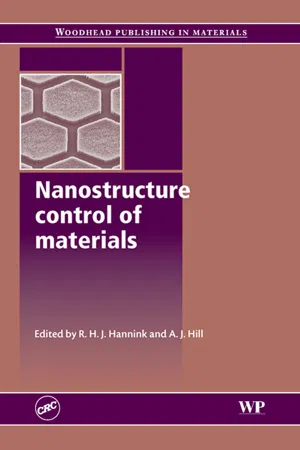
- 368 pages
- English
- ePUB (mobile friendly)
- Available on iOS & Android
Nanostructure Control of Materials
About This Book
The ability to measure and manipulate matter on the nanometer level is making possible a new generation of materials with enhanced mechanical, optical, transport and magnetic properties. This important book summarises key developments in nanotechnology and their impact on the processing of metals, polymers, composites and ceramics.After a brief introduction, a number of chapters discuss the practical issues involved in the commercial production and use of nanomaterials. Other chapters review ways of nanoengineering steel, aluminium and titanium alloys. Elsewhere the book discusses the use of nanoengineered metal hydrides to store hydrogen as an energy source, and the development of nanopolymers for batteries and other energy storage devices. Other chapters discuss the use of nanotechnology to enhance the toughness of ceramics, the production of synthetic versions of natural materials such as bone, and the development of nanocomposites.Nanostructure control of materials is an ideal introduction to the ways nanotechnology is being used to create new materials for industry. It will be welcomed by R&D managers in such sectors as automotive engineering as well as academics working in this exciting area.
- Reviews key developments in nanotechnology and their impact on various materials
- Edited by leading experts in the field
Frequently asked questions
Information
Nanoparticle technologies and applications
Publisher Summary
1.1 Introduction
| Two dimensions (few nm in diameter, length up to several cm) | Three dimensions (<100 nm in diameter) |
| carbon nanotubes (single and multi wall) | nanoparticles (particles |
| inorganic nanotubes | < 100 nm in diameter) |
| carbon and inorganic nanorods | fullerenes (C60) |
| nanoplatelets | dendrimers |
| nanofibrils | quantum dots |
| nanowires | |
| biopolymers |
Table of contents
- Cover image
- Title page
- Table of Contents
- Related titles
- Copyright
- Contributor contact details
- Foreword
- Acknowledgements
- Introduction: special properties resulting from nanodimensionality
- Chapter 1: Nanoparticle technologies and applications
- Chapter 2: Nanometric architectures: emergence of efficient non-crystalline atomic organization in nanostructures
- Chapter 3: Nanostructure characterisation using electron-beam techniques
- Chapter 4: Organic-inorganic nanocomposite membranes for molecular separation processes
- Chapter 5: Developing fast ion conductors from nanostructured polymers
- Chapter 6: Nanostructures in biological materials
- Chapter 7: Mechanical behavior of metallic nanolaminates
- Chapter 8: Preparation of monolithic nanocrystalline ceramics
- Chapter 9: Nanoengineering of metallic materials
- Chapter 10: Using magnetic resonance to study nanoprecipitation in light metal alloys
- Chapter 11: Nanocrystalline light metal hydrides for hydrogen storage
- Chapter 12: Nanofabrication
- Index